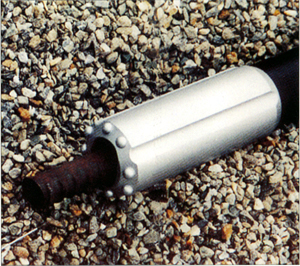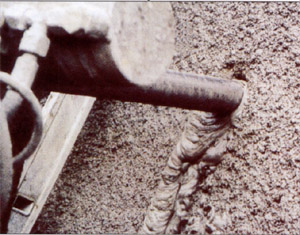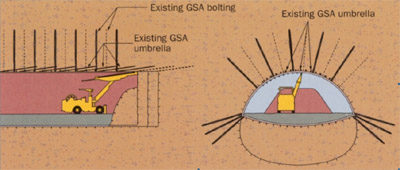You are here
GSA stability for difficult ground
GSA stability for difficult ground
with drilling and spiling in one easy integrated procedure
The Grouted Spile Anchor for pre-stabilisation of non-cohesive soil in one integrated step.
 Stability of the face is a constant problem for tunnellers, particularly those using open-face tunnelling methods, such as the NATM, which do not provide for positive mechanical support of the face. Forepoling or spiling is a popular method for controlling the face and stabilising the ground ahead of a soft ground tunnel or to bridge fractured zones in hard rock TBM or drill+blast tunnels.
Stability of the face is a constant problem for tunnellers, particularly those using open-face tunnelling methods, such as the NATM, which do not provide for positive mechanical support of the face. Forepoling or spiling is a popular method for controlling the face and stabilising the ground ahead of a soft ground tunnel or to bridge fractured zones in hard rock TBM or drill+blast tunnels.
But current methods of installing the spiling rods have their limitations. The drill holes often collapse, particularly in weak friable ground, before the rod can be inserted and the spiling cycle is time-consuming, which can be detrimental in soft ground conditions where consistent progress to prevent the initiation of ground movement is vital.
Being well aware of these problems and highly experienced in the application of the NATM, Dr. Gerhard Sauer has developed a new spiling system to greatly improve current practices. Known as the grouted spile anchor (GSA), the principle is to bore the hole and insert the spiling rod in one single integrated step.
Immediately after excavation of a round, the tunnel walls and face are covered with a thin layer of flash-shotcrete to stabilise the ground. Installation of the next GSA pattern is then carried out under the protection of the previous round. The GSA anchor itself is actually fitted inside the drilling rod, the tip of the anchor sitting behind the sacrificial drill bit, which is made of either steel or steel with a tungsten carbide insert.
 Drilling with flush
|
About half a metre before reaching the end of the drill hole, the flushing medium, whether it be air or water, is exchanged for the grouting material. The grout is pumped down the drill rod in the annular space between the solid anchor shaft and hollow drill rod to reach the top of the rod when the boring is finished. The drill rod is then withdrawn while the anchor is rejected by the continuing pressure of the grout feed. This removing procedure not only keeps the anchor at the end of the hole, it also centres it in the grout material, thus ensuring complete and even corrosion protection. |
 Replacement of flush head with anchor
|
Just before the rod is retracted from the drilled hole, the flushing medium is reintroduced to clear the drill rod of grout before it finally leaves the hole. After a final flush with water or special flushing liquid, the GSA drill rod is reloaded with the next anchor either by turning the boom 90o and feeding the anchor through the front end or by disconnecting the drill rod from the drifter and inserting the anchor from the back. |
 Retraction of drilling barrel with constant grout injection
|
The GSA is suitable for application in all ground types, from hard rock to water bearing and non-cohesive sands, gravels and clay. The anchor can be made of steel, plastic or glass fibre and grout material can be either cement mortar, resin or sodium silicate twopart mix. |
With minor modifications, the GSA system can be used with any of the currently available drilling jumbos. The jumbo must be fitted with a grout hopper and pump and a special two-way valve has to be incorporated on the water flushing line. A special larger diameter drill rod is also necessary to carry the anchor. This is included in the GSA system package and is compatible with all current drifter makes.
The GSA is becoming a popular method for controlling difficult ground in excavations and tunnels.

